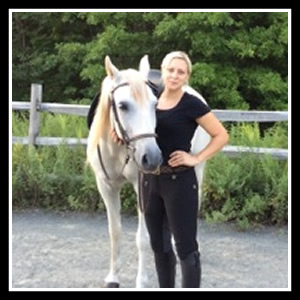How To Develop the Sitting Trot

So today, we are talking about introducing the young horse to the sitting trot.
The biggest mistake that most people make with this, is they sit too long. Young horse’s backs take quite a while to form, so if you just drop your stirrups (as so many people do), you will probably end up hollowing the back of the horse, because the horse won’t be able to sustain it.
So, when your first beginning the sitting trot on a horse, what you want to do is get them into the stretch, and then only sit in the stretch. This teaches the rider independence as well. My student Sarah in this video, is working with a horse that has only had a few weeks of dressage training, and is learning to stretch. To get him back in place, she waits a moment till she gets the horse into the stretch and then sits to the trot alternating every 3 strides.
3 strides rising and 3 strides sitting and then she is back out of the saddle. But if the horse hollows again, she is going to take a moment before she sits again, get the horse back into the stretch once again, get the back up where it can sustain the weight of the rider, and then sit 3 strides again. Then again she starts to rise. When it is correct, our goal is to see no change between the sitting and rising trot.
So often in dressage today, we see people rise in the trot and as soon as they sit they shorten the gait of the horse. That will ruin the horse’s gait. We have to learn to sit to real true working gaits. The best way to do it, even for the rider, is to introduce a few strides at a time instead of dropping the stirrups and sitting for a half hour of time. This will ruin the horse’s back, and will also interestingly enough create damage to the rider’s back. If the back isn’t up and supporting, your going to take a lot of concussion into your own back. This is the way we do this, stretching into the contact and only sitting when the horse is stretching. As soon as the horse hollows, bring him back up and get the horse correct again, and try again. In the video, he hollows again, which tells us this horse’s back may be getting a little tired at this point. We will try to get one more good one and then we will quit. Then we bring the horse back to the walk.
Thank you all very much! So, get the stretch first, and then only sit 3 strides at a time. When you can get 3 strides at a time without changing the gaits of the horse, then sit 5 strides…then 7. Always use odd numbers, that way you will always come up on the outside diagonal. Thanks very much, and have a great day!
5 responses to “How To Develop the Sitting Trot”
Leave a Reply
I truly enjoyed reading it. Waiting for some more great stuff like this from you in the coming days.
Love learning this and that you teach riders to be gentle, slow and patient with advances and to respect the horse above all.
Can you explain why this rider is sea- sawing on the reins each time the horse raises its head and neck and hollowing? It seems to have the effect of getting the horse to lower its neck again, however, “Classically” this rein aid is incorrect and constitutes an alternating backwards pull on the mouth using the bicep arm muscles. (a brutal way to communicate with the mouth). Is not educating the rider to use just their small fingers on the reins with a squeeze (followed by an instantaneous release of the little finger until the horse lowers its neck) more correct? This is achieved by maintaining the contact between the index finger and the thumb with the thumb nails pointing skywards at all times. Is this manner of using the small fingers to communicate to the horse not more correct???
-
Having watched numerous numerous videos of Will’s training methods Etc it looks to me more that she is widening her hands and yes there may be a slight backwards movement with the elbows but from practicing this method of training that movement is in response to taking up the slack within the reins to maintain the contact. When the horse raises its head you are left with quite a bit of spare rein which has to be taken up pretty quickly to maintain the contact. Once it lowers again you have all the rein required to allow this lowering, by bringing your hands back into the working position. This is how I see it and from practicing the methods is how I also ride. To gather the reins through your hands would take too much time to do as the horse very often lowers and stretches again within a stride or two, which then mean you letting the reins slip again to accommodate the stretch. I personally didn’t see any undue contact on the horses mouth, just a steady constant contact. Jus show I see it and obviously my own personal opinion. Absolutely love the videos and tutorials and will be submitting my own video for critique at some point Will….
Dear Mr Faeber,
THANK YOU ! THANK YOU! THANK YOU!!
I have been watching your videos for weeks now and have learned so much! I have been riding for over 30 years, taking lessons most of that time, from many sources. Most of my instructors were high level riders. It seems that this stretching you are teaching has been a very important concept that has been missing in my riding. Of course it makes sense that the horse would be more comfortable if his back is strong and not constricted. I have known many great riders but only a few that can express what they know in a way anyone can understand.
I have always heard ride back to front, or ride the back end, but the stretching work is adding another level.
I am inspired and hope you continue to share how to keep horses happy and sound!!
Sincere Thanks





I truly enjoyed reading it. Waiting for some more great stuff like this from you in the coming days.
Love learning this and that you teach riders to be gentle, slow and patient with advances and to respect the horse above all.
Can you explain why this rider is sea- sawing on the reins each time the horse raises its head and neck and hollowing? It seems to have the effect of getting the horse to lower its neck again, however, “Classically” this rein aid is incorrect and constitutes an alternating backwards pull on the mouth using the bicep arm muscles. (a brutal way to communicate with the mouth). Is not educating the rider to use just their small fingers on the reins with a squeeze (followed by an instantaneous release of the little finger until the horse lowers its neck) more correct? This is achieved by maintaining the contact between the index finger and the thumb with the thumb nails pointing skywards at all times. Is this manner of using the small fingers to communicate to the horse not more correct???
Having watched numerous numerous videos of Will’s training methods Etc it looks to me more that she is widening her hands and yes there may be a slight backwards movement with the elbows but from practicing this method of training that movement is in response to taking up the slack within the reins to maintain the contact. When the horse raises its head you are left with quite a bit of spare rein which has to be taken up pretty quickly to maintain the contact. Once it lowers again you have all the rein required to allow this lowering, by bringing your hands back into the working position. This is how I see it and from practicing the methods is how I also ride. To gather the reins through your hands would take too much time to do as the horse very often lowers and stretches again within a stride or two, which then mean you letting the reins slip again to accommodate the stretch. I personally didn’t see any undue contact on the horses mouth, just a steady constant contact. Jus show I see it and obviously my own personal opinion. Absolutely love the videos and tutorials and will be submitting my own video for critique at some point Will….
Dear Mr Faeber,
THANK YOU ! THANK YOU! THANK YOU!!
I have been watching your videos for weeks now and have learned so much! I have been riding for over 30 years, taking lessons most of that time, from many sources. Most of my instructors were high level riders. It seems that this stretching you are teaching has been a very important concept that has been missing in my riding. Of course it makes sense that the horse would be more comfortable if his back is strong and not constricted. I have known many great riders but only a few that can express what they know in a way anyone can understand.
I have always heard ride back to front, or ride the back end, but the stretching work is adding another level.
I am inspired and hope you continue to share how to keep horses happy and sound!!
Sincere Thanks